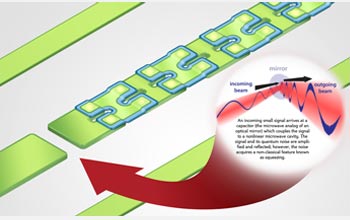Multimedia Gallery
Illustration of a nanoscale experiment.
An incoming small signal arrives at a capacitor (the microwave analog of a mirror) which couples the signal into a non-linear microwave cavity. The signal and its quantum noise are amplified and reflected; however, the noise acquires a non-classical feature known as squeezing.
In this illustration, the white areas depict the silicon substrate of the coplanar waveguide, the green strips are superconducting niobium metal, and the blue lines are thin dielectric (insulating) layers. The yellow areas are Josephson junctions, each consisting of three layers: niobium, aluminum oxide and niobium.
The incoming small microwave signal gets reflected by the capacitor (the small white area between two green strips) into the microwave cavity (green strip with blue lines). In the yellow areas, electrons from the niobium metal 'tunnel' back and forth through the aluminum oxide layer, causing an electric signal to flow. Not shown: A large magnetic coil surrounding the device applies a magnetic field to the Josephson junctions, which disrupts the electric signal.
Credit: Greg Kuebler, JILA, University of Colorado 2008-9
Images credited to the National Science Foundation, a federal agency, are in the public domain. The images were created by employees of the United States Government as part of their official duties or prepared by contractors as "works for hire" for NSF. You may freely use NSF-credited images and, at your discretion, credit NSF with a "Courtesy: National Science Foundation" notation.
Additional information about general usage can be found in Conditions.
Also Available:
Download the high-resolution JPG version of the image. (270 KB)
Use your mouse to right-click (Mac users may need to Ctrl-click) the link above and choose the option that will save the file or target to your computer.
Related story: Squeezing Noise Below Quantum Limits



